初中英语语法之句子的种类
- 格式:ppt
- 大小:816.00 KB
- 文档页数:65
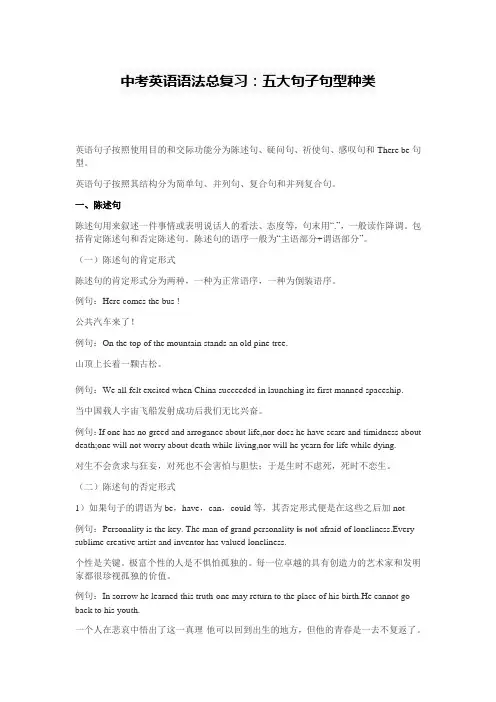
中考英语语法总复习:五大句子句型种类英语句子按照使用目的和交际功能分为陈述句、疑问句、祈使句、感叹句和There be句型。
英语句子按照其结构分为简单句、并列句、复合句和并列复合句。
一、陈述句陈述句用来叙述一件事情或表明说话人的看法、态度等,句末用“.”,一般读作降调。
包括肯定陈述句和否定陈述句。
陈述句的语序一般为“主语部分+谓语部分”。
(一)陈述句的肯定形式陈述句的肯定形式分为两种,一种为正常语序,一种为倒装语序。
例句:Here comes the bus !公共汽车来了!例句:On the top of the mountain stands an old pine tree.山顶上长着一颗古松。
例句:We all felt excited when China succeeded in launching its first manned spaceship.当中国载人宇宙飞船发射成功后我们无比兴奋。
例句:If one has no greed and arrogance about life,nor does he have scare and timidness about death;one will not worry about death while living,nor will he yearn for life while dying.对生不会贪求与狂妄,对死也不会害怕与胆怯;于是生时不虑死,死时不恋生。
(二)陈述句的否定形式1)如果句子的谓语为be,have,can,could等,其否定形式便是在这些之后加not例句:Personality is the key. The man of grand personality is not afraid of loneliness.Every sublime creative artist and inventor has valued loneliness.个性是关键。
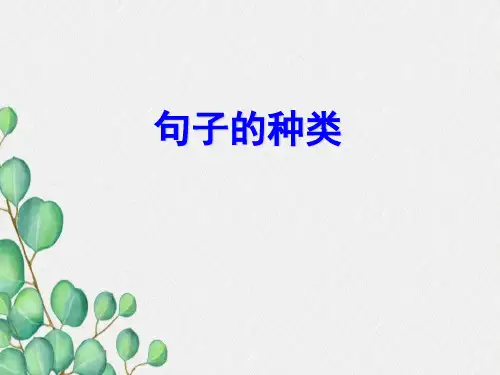
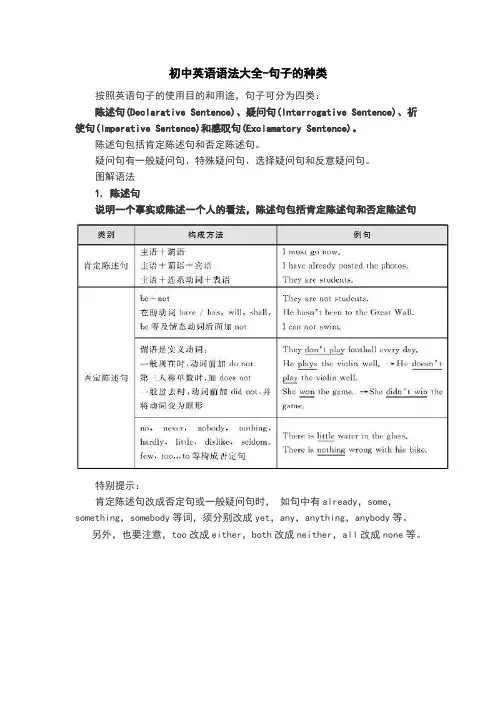
初中英语语法大全-句子的种类按照英语句子的使用目的和用途,句子可分为四类:陈述句(Declarative Sentence)、疑问句(Interrogative Sentence)、祈使句(Imperative Sentence)和感叹句(Exclamatory Sentence)。
陈述句包括肯定陈述句和否定陈述句。
疑问句有一般疑问句、特殊疑问句、选择疑问句和反意疑问句。
图解语法1. 陈述句说明一个事实或陈述一个人的看法,陈述句包括肯定陈述句和否定陈述句特别提示:肯定陈述句改成否定句或一般疑问句时,如句中有already,some,something,somebody等词,须分别改成yet,any,anything,anybody等。
另外,也要注意,too改成either,both改成neither,all改成none等。
2. 疑问句3. 常用的特殊疑问句4. 特殊的反意疑问句①主句是祈使句时,“will you?”意为“请求”,“won’t you?”表示提醒对方注意。
例句:Look at the blackboard, will you / won’t you?Don’t be late again, will you?②感叹句后的反意疑问,用一般现在时态的否定形式例句:What fine weather, isn’t it?How beautifully she sings, doesn’t she?③陈述部分是“I am …”时,用“aren’t I?”而不用“am not I?”例句:I'm working now, aren’t I?④陈述部分主语是everything,nothing,anything或something 时,疑问句主语用it例句:Something is wrong with my radio, isn’t it?Nothing is difficult, is it?⑤陈述部分的主语是somebody, nobody, everybody, anybody, no one,none, neither 时,疑问句的主语用they例句:Everyone is here, aren’t they?No one knows about it, do they?⑥陈述部分的主语是:1) this或that时,问句的主语用it2) these或those时,问句主语用they3) there be句时,反意疑问句中用there例句:This is a plane, isn’t it?These are grapes, aren’t they?There was a hospital here, wasn’t there?⑦陈述部分的主语是one时,问句的主语可用one,也可用you (美语用he)例句:One should be ready to help others, shouldn’t one?⑧陈述句中有few, seldom, never hardly,not,rarely,no,nobody,too…to等时,疑问句部分用肯定结构;如由前后缀构成否定词,疑问句部分仍用否定结构例句:He is never late for school, is he?You got nothing from him, did you?It is useless, isn’t it?⑨陈述部分主语是从句、不定式(短语)、动词-ing形式时,疑问句的主语用it例句:What you need is more important, isn’t it?⑩陈述部分由think, believe, suppose, imagine等引导的宾语从句:1) 主语是第一人称时,问句与从句的主谓语一致2) 主语是其他人称,问句与主句的主谓语一致例句:I think he will come, won’t he?I don’t think he can pass the exam, can he?He believed you had seen her before, didn’t he?? have是实义动词时,疑问句用助动词do,does,did;have 是助动词,则不然例如:They had a meeting just now, didn’t they?She’s been to many places of interest, hasn’t she?? 陈述部分有have /has /had to 时,疑问句要用助动词的否定形式例句:You have to water the vegetables now, don’t you?? 陈述部分有had better时,疑问句中用hadn’t刘局:We had better go to school at once, hadn’t we?? 陈述部分有must:1) 作“一定;必须”解释时,疑问句用mustn’t或needn’t;2) 表示推测,作“一定是;必定”解释时,疑问句需根据其后的动词原形选用相应的形式;3) 对过去动作推测时,问句的助动词用did或have;4) 对过去的状态推测时,问句的be用was例句:He must work hard at physics, mustn’t he?You must go to Guangzhou, needn’t you?You mustn’t smoke here, must you?Tom must be at home, isn’t he?She must have finished her work, hasn’t/didn’t she?He must have been a policeman, wasn’t he?? 陈述部分有ought to,used to,疑问句要用 shouldn’t,usedn’t / didn’t例句:Jill used to be a teacher, usedn’t / didn’t she?? 陈述句部分是复合句时,疑问句的主语和助动词要与主句一致例句:He was reading when the teacher came in, wasn’t he?特别提示:反意疑问句是“否定陈述句+肯定问句”时,如回答内容是肯定的,用“Yes+肯定结构”,反之,用“No+否定结构”。
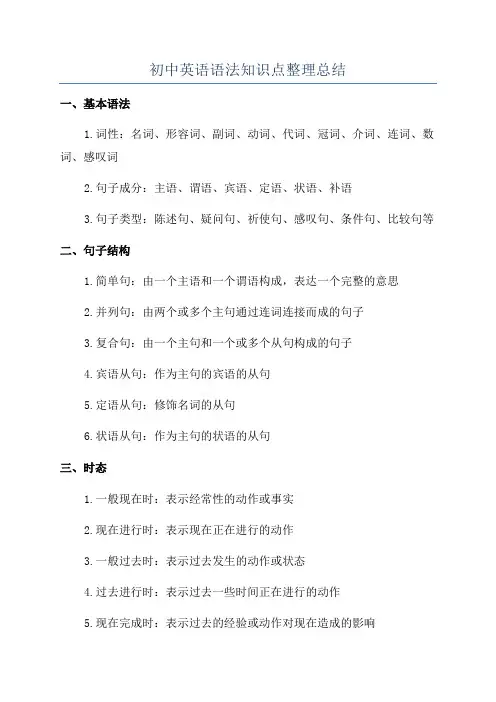
初中英语语法知识点整理总结一、基本语法1.词性:名词、形容词、副词、动词、代词、冠词、介词、连词、数词、感叹词2.句子成分:主语、谓语、宾语、定语、状语、补语3.句子类型:陈述句、疑问句、祈使句、感叹句、条件句、比较句等二、句子结构1.简单句:由一个主语和一个谓语构成,表达一个完整的意思2.并列句:由两个或多个主句通过连词连接而成的句子3.复合句:由一个主句和一个或多个从句构成的句子4.宾语从句:作为主句的宾语的从句5.定语从句:修饰名词的从句6.状语从句:作为主句的状语的从句三、时态1.一般现在时:表示经常性的动作或事实2.现在进行时:表示现在正在进行的动作3.一般过去时:表示过去发生的动作或状态4.过去进行时:表示过去一些时间正在进行的动作5.现在完成时:表示过去的经验或动作对现在造成的影响6.过去完成时:表示过去一些时间或动作之前的完成动作四、语态1.被动语态:由动词的宾语和过去分词构成,强调动作的承受者而不是执行者2.主动语态:动词主语直接执行动作五、形容词和副词1.形容词修饰名词,副词修饰动词、形容词或副词2.形容词和副词的比较级和最高级3.形容词和副词的用法及修饰位置六、名词1.可数名词和不可数名词的区别及用法2.名词的单数和复数形式3.名词所有格的构成和用法七、代词1.人称代词、物主代词、反身代词、指示代词、不定代词等2.代词的主格和宾格形式3.代词的用法及位置八、冠词1.定冠词和不定冠词的区别及用法2.冠词的用法及位置九、动词1.动词的时态、语态、主动和被动形式2.动词的不同意思和用法3.动词的非谓语形式:不定式、现在分词、过去分词4.动词的用法和位置十、介词1.介词的基本用法和位置2.常用介词和短语的用法和搭配十一、连接词1.连词的分类及用法:并列连词、从属连词、关联连词等2.连词引导的从句的构成和用法以上是初中英语语法的一些基本知识点总结,希望能帮助到你。
记住这些基本知识点,然后通过大量的练习和阅读来巩固和运用,可以帮助你在英语学习中取得好的成绩。
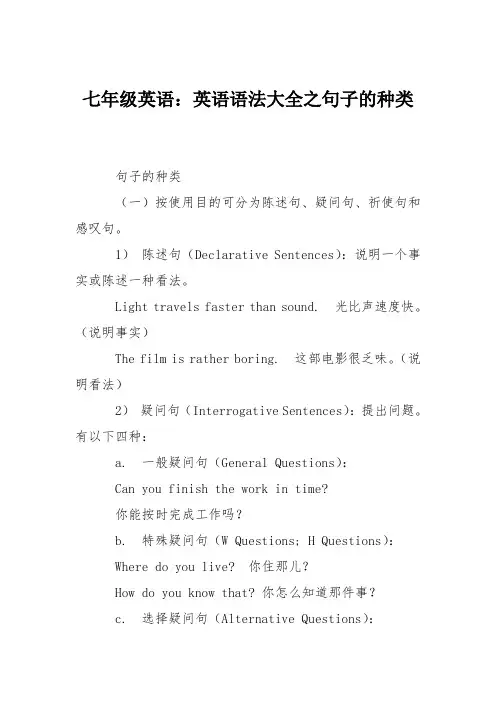
七年级英语:英语语法大全之句子的种类句子的种类(一)按使用目的可分为陈述句、疑问句、祈使句和感叹句。
1)陈述句(Declarative Sentences):说明一个事实或陈述一种看法。
Light travels faster than sound. 光比声速度快。
(说明事实)The film is rather boring. 这部电影很乏味。
(说明看法)2)疑问句(Interrogative Sentences):提出问题。
有以下四种:a. 一般疑问句(General Questions):Can you finish the work in time?你能按时完成工作吗?b. 特殊疑问句(W Questions; H Questions):Where do you live? 你住那儿?How do you know that? 你怎么知道那件事?c. 选择疑问句(Alternative Questions):Do you want tea or coffee?你是要茶还是要咖啡?d. 反意疑问句(Tag-Questions):He doesn’t know her, does he?他不认识她,对不对?3)祈使句(Imperative Sentences):提出请求,建议或发出命令,例如:Sit down, please. 请坐。
Don’t be nervous!别紧张!4)感叹句(Exclamatory Sentences):表示说话人惊奇、喜悦、愤怒等情绪,例如:What good news it is! 多好的消息啊!(二)句子按其结构可以分为以下三类:1)简单句(Simple Sentences):只包含一个主谓结构句子叫简单句,例如:She is fond of collecting stamps. 她喜欢集邮。
(主) (谓)2)并列句(Compound Sentences):包含两个或两个以上主谓结构的句子叫并列句,句与句之间通常用并列连词或分号来连接,例如:The food was good, but he had little appetite.(主) (谓) (主)(谓)食物很精美,但他却没什么胃口。
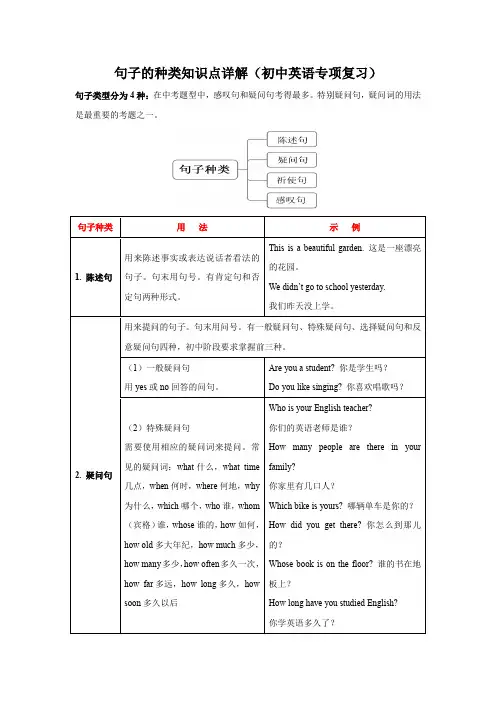
句子的种类知识点详解(初中英语专项复习)句子类型分为4种:在中考题型中,感叹句和疑问句考得最多。
特别疑问句,疑问词的用法是最重要的考题之一。
【典例】1. 他们还赢得了广东省飞镖比赛冠军。
多么棒的项目啊!They won the Championship of Guangdong Darts Match, too. ________________________ project it is!【答案】What a wonderful【解析】根据题干可知此处是一个感叹句。
中心词为可数名词project“项目”,符合结构:What+ a/an+形容词+主语+谓语。
project是以辅音音素开头,应用a;wonderful“极好的”。
故填What a wonderful。
2.. ________ it was to see the main sights of the world in the World Park!A How amazing day B. How an amazing dayC. What amazing dayD. What an amazing day【答案】D【解析】句意:在世界公园里看到世界的主要景点是多么美妙的一天啊!考查感叹句。
句子是感叹句,中心词是可数名词单数day,用感叹句结构:What a/an adj. n.+主谓。
故选D。
3.. —China won all the gold medals at the 2023 World Table Tennis Championships.—______ exciting news!A. What aB. How aC. HowD. What 【答案】D【解析】句意:——中国包揽了2023年世乒赛的所有金牌。
——多么令人兴奋的消息啊!考查感叹句,感叹句的中心词news是不可数名词,此处用“What+形容词+不可数名词”结构。
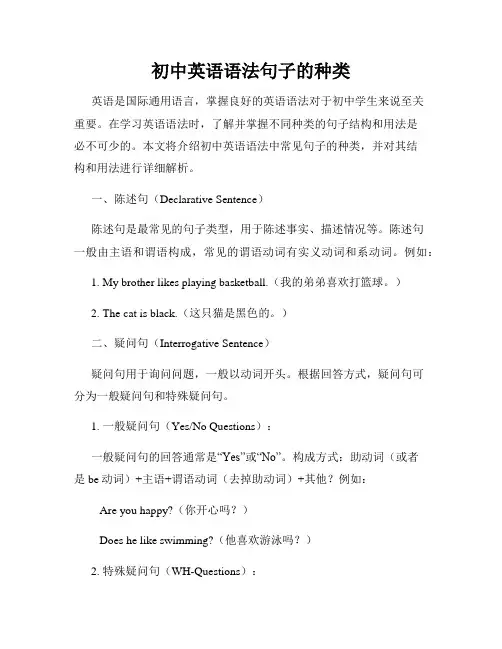
初中英语语法句子的种类英语是国际通用语言,掌握良好的英语语法对于初中学生来说至关重要。
在学习英语语法时,了解并掌握不同种类的句子结构和用法是必不可少的。
本文将介绍初中英语语法中常见句子的种类,并对其结构和用法进行详细解析。
一、陈述句(Declarative Sentence)陈述句是最常见的句子类型,用于陈述事实、描述情况等。
陈述句一般由主语和谓语构成,常见的谓语动词有实义动词和系动词。
例如:1. My brother likes playing basketball.(我的弟弟喜欢打篮球。
)2. The cat is black.(这只猫是黑色的。
)二、疑问句(Interrogative Sentence)疑问句用于询问问题,一般以动词开头。
根据回答方式,疑问句可分为一般疑问句和特殊疑问句。
1. 一般疑问句(Yes/No Questions):一般疑问句的回答通常是“Yes”或“No”。
构成方式:助动词(或者是be动词)+主语+谓语动词(去掉助动词)+其他?例如: Are you happy?(你开心吗?)Does he like swimming?(他喜欢游泳吗?)2. 特殊疑问句(WH-Questions):特殊疑问句通常以疑问词(如what, where, when, why, how等)开头,回答需要提供具体信息。
例如:What is your name?(你叫什么名字?)Where does she live?(她住在哪儿?)三、祈使句(Imperative Sentence)祈使句用于表达请求、命令或建议等,一般省略主语。
常用动词原形构成祈使句,例如:1. Sit down, please.(请坐。
)2. Don't be late for class.(上课不要迟到。
)四、感叹句(Exclamatory Sentence)感叹句用于表达强烈的感情或情绪。
常常以感叹词(如how, what 等)开头。

初中英语语法之句子的种类英语中的句子按其使用目的,句子可分为:陈述句、疑问句、祈使句、和感叹句。
按语法结构,句子可分为简单句、并列句和复合句。
Eg:陈述句:This is a dog.疑问句:Is this a dog?祈使句:Open your eyes!感叹句:What a beautiful building it is!简单句:I am studying.并列句:I was born in a small village and I lived there for nearly ten years.复合句:As soon as I get there, I’ll call you.1 陈述句凡是说明一件事情,提出一个看法,或者是表达一种心情的句子都是陈述句。
大多数的句子都是陈述句,陈述句可以用肯定式和否定式。
陈述句句末用句号“.”,通常用降调。
Eg:We live in Beijing.We don’t live in Beijing.(1) be 动词、一般动词(实义动词)、情态动词的否定句I am not a student.I don’t know him.He can’t speak English.01. be 动词的否定句句型:主语+ be动词+ not + …I wasn’t good at English.They weren’t at home yesterday.He isn’t my cousin.进行时和被动语态都有be 动词,它们的否定句与be动词的否定句同形。
Eg:They aren’t cleaning the room.The child was not looked after by anybody.将来时(will,shall)、完成时及情态动词的被动语态不能用be动词否定句型。
They will not be sent to the front.They will be not sent to the front.×02 情态动词的否定句句型:主语+情态动词+ not + 动词原形Eg:I can’t do it myself.You mustn’t take the books out.You must not go there alone.03 一般动词的否定句句型:主语+ do/does/did + not + 动词原形Eg:They didn’t live in Shanghai.He doesn’t do his homework every day.They didn’t have the class-meeting yesterday afternoon.04现在完成时的否定句句型:主语+ have/has+ not + 动词的过去分词+……I haven’t finished reading the book yet.He hasn’t had his breakfast yet.05过去完成时的否定句句型:主语+ had+ not + 动词的过去分词+……He had n’t finished reading the book by the end of last month.(2).否定结构应注意事项01 使用not 的部分否定含有not的句子,如果使用了very, always以及不定代词all, both, every 及every的复合词,则表示部分否定。
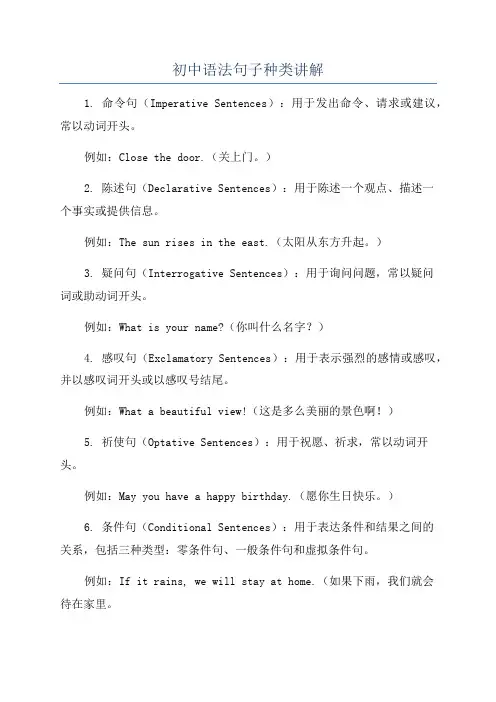
初中语法句子种类讲解1. 命令句(Imperative Sentences):用于发出命令、请求或建议,常以动词开头。
例如:Close the door.(关上门。
)2. 陈述句(Declarative Sentences):用于陈述一个观点、描述一个事实或提供信息。
例如:The sun rises in the east.(太阳从东方升起。
)3. 疑问句(Interrogative Sentences):用于询问问题,常以疑问词或助动词开头。
例如:What is your name?(你叫什么名字?)4. 感叹句(Exclamatory Sentences):用于表示强烈的感情或感叹,并以感叹词开头或以感叹号结尾。
例如:What a beautiful view!(这是多么美丽的景色啊!)5. 祈使句(Optative Sentences):用于祝愿、祈求,常以动词开头。
例如:May you have a happy birthday.(愿你生日快乐。
)6. 条件句(Conditional Sentences):用于表达条件和结果之间的关系,包括三种类型:零条件句、一般条件句和虚拟条件句。
例如:If it rains, we will stay at home.(如果下雨,我们就会待在家里。
例如:She likes to read books, and he likes to play sports.(她喜欢看书,他喜欢运动。
)例如:I will go to bed early because I am tired.(因为我累了,所以我会早点上床睡觉。
)这些是初中语法句子的主要种类,根据不同的语法结构和用途,可以组成不同类型的句子。
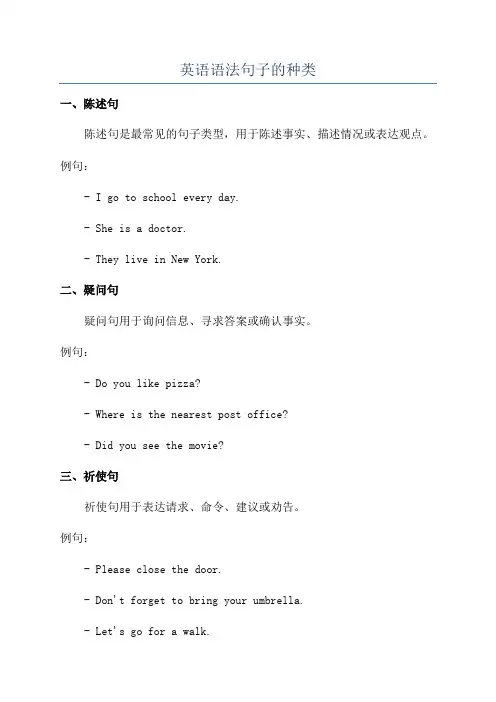
英语语法句子的种类一、陈述句陈述句是最常见的句子类型,用于陈述事实、描述情况或表达观点。
例句:- I go to school every day.- She is a doctor.- They live in New York.二、疑问句疑问句用于询问信息、寻求答案或确认事实。
例句:- Do you like pizza?- Where is the nearest post office?- Did you see the movie?三、祈使句祈使句用于表达请求、命令、建议或劝告。
例句:- Please close the door.- Don't forget to bring your umbrella.- Let's go for a walk.四、感叹句感叹句用于表达惊讶、赞美、失望或其他强烈的情感。
例句:- What a beautiful sunset!- How delicious the food is!- I can't believe we won the game!五、条件句条件句用于表达条件和结果之间的关系。
例句:- If it rains, we will stay indoors.- Unless you study hard, you will fail the exam.六、比较句比较句用于表示两个或多个事物之间的比较。
例句:- John is taller than Peter.- She sings better than him.- I prefer coffee to tea.七、否定句否定句用于否定陈述句中的内容。
例句:- I didn't see him at the party.- She doesn't like spicy food.- They haven't visited that museum before.。

初中英语语法句子的种类英语是一门广泛使用的语言,在初中阶段,学生学习英语语法是非常重要的。
了解不同种类的句子结构和语法规则,可以帮助学生更好地理解和运用英语。
本文将介绍初中英语中常见的句子种类。
1. 简单句简单句是由一个主语和一个谓语构成的句子。
主语通常是一个名词或代词,而谓语则是一个动词或者动词短语。
例如:- I study English every day.- He is a good student.2. 并列句并列句由两个或多个简单句组成,它们通过连词(如and、but、or)相连。
两个并列句的结构和语法相似。
例如:- I like playing basketball, and my sister likes playing tennis.- He is not only smart but also hardworking.3. 复合句复合句由一个主句和一个或多个从句组成。
从句可以作为主句的一部分,承担名词、形容词或副词的功能。
从句通常由连词(如because、when、although)引导。
例如:- I like the movie, which was released last week.- He went to bed early because he was tired.4. 条件句条件句是由一个条件从句和一个主句构成的句子。
条件从句通常由if引导,表示某种条件或假设。
例如:- If it rains, we will stay at home.- She will be late unless she hurries up.5. 疑问句疑问句是用来提问的句子。
一般疑问句以助动词或be动词开头,也可以以疑问词开头。
例如:- Do you like pizza?- Where is the library?6. 感叹句感叹句用于表示惊讶、赞美、喜悦等情感。
感叹句通常以“What”或“How”开头。
句子的种类英语句子按照使用目的和交际功能,可分为四大类陈述句、疑问句、祈使句和感叹句.一.陈述句1、陈述句:说明一个事实或陈述一个看法,有肯定式和否定式,语序是主语在前,谓语在后。
2.掌握陈述句的肯定式和否定式的构成及用法。
e。
g。
We live in Tianjin。
(肯定句)我们住在天津。
We don’t live in Shanghai。
(否定句)我们不住在上海。
注意:(1)在一般现在时的肯定式中,主语是第三人称单数时,动词要改成第三人称单数形式.e.g。
John studies Chinese very well。
(2)若句中有be动词、情态动词或助动词,则分别在他们的后面加not.Sometimes you're supposed to come early. (变为否定句)(3)若句中有be动词、情态动词或助动词,要在行为动词(实义动词)前面加助动词do/does,did等与not的缩写形式,并注意这使得行为动词要用原型。
另外,还需将原句中some变成any,too改为either,already改为yet。
e。
g。
I don't like swimming. 我不喜欢游泳。
He doesn’t have lunch at home every day。
他每天不在家吃午饭。
They didn’t play football yesterday。
他们昨天没有踢足球.He did some work this morning。
(改为否定句)He didn't do any work this morning。
二.疑问句疑问句用来提出问题,句末用问号“?”。
常见的疑问句有:一般疑问句、特殊疑问句、选择疑问句和反意疑问句。
(一)一般疑问句:1.用来询问一件事,答案通常是yes或no,注意语序。
e。
g。
Do you often speak English at school ? 在学校你常讲英语吗?Yes, I do. /No,I don’t。
初中语法句子种类讲解完整版1. 陈述句(Declarative Sentence):陈述句是用来陈述事实或表达其中一种观点的句子。
陈述句通常以陈述句调升降或陈述句调降提。
例如:- The sun rises in the east.(太阳东升。
)- I like playing basketball.(我喜欢打篮球。
)2. 疑问句(Interrogative Sentence):疑问句是用来提出问题的句子。
疑问句通常以疑问句调升提或疑问句调降提。
例如:- Did you finish your homework?(你完成作业了吗?)- What is your name?(你叫什么名字?)3. 祈使句(Imperative Sentence):祈使句是用来表示请求、命令或建议的句子。
祈使句的主语通常是第二人称(你)或省略。
例如:- Please close the door.(请关上门。
)- Let's go to the park.(让我们去公园吧。
4. 感叹句(Exclamatory Sentence):感叹句是用来表达感叹、惊讶或强调的句子。
感叹句通常以感叹句调升降或感叹句调降提。
例如:- What a beautiful flower!(多么美丽的花啊!)- How brave they are!(他们多么勇敢啊!)除了这些基本的句子种类外,还有一些复合句子的种类,如复合句、并列句、从句等。
但是在初中语法中,主要讨论的是简单句。
这些句子种类的使用取决于不同的语境和表达目的,要根据具体情况选择恰当的句子类型。
初中英语语法-- 句子的种类(学生版)初中英语语法--句子的种类英语中的句子可以按其作用或者按其语法结构(即句子的形式)两种标准分类。
下面是具体的分类依据和结果。
1)按其作用或使用目的,句子可分为:陈述句: This is a truck. 这是一辆卡车。
疑问句:Is this a truck? 这是卡车吗?祈使句: Drive the truck away. 把卡车开走。
感叹句: What a big truck it is! 多么大的卡车! 2)按语法结构,句子可分为:简单句:I am busy. 我很忙。
并列句:I am busy washing, but he is playingMajiang with them.我在忙着洗衣服,但他却在跟他们打麻将牌。
复合句:A lthough I am busy washing, he isplaying Majiang with them.尽管我在忙着洗衣服,他却在与他们一块打麻将牌。
一、陈述句:用于说明一件事,表示一种看法或表达某种心情You didn't do your homework seriously. 你没有认真地做你的作业。
(一般过去时)You mustn't take her to your parents. 你千万不要把她带到你的父母那里去。
(情态动词)She needn't quarrel with him. 她没必要跟他吵。
(情态动词)The house won't be painted. 这所房子将不粉刷了。
(被动语态将来时)She might not notice you. 她可能没有注意到你。
(情态动词)各种时态肯定句变否定句:变成否定句有规则,“是”,“有”“ 将”后加 not,假如没有“是”,“有”,“将”,动词前面加 don't(does't/didn't)。